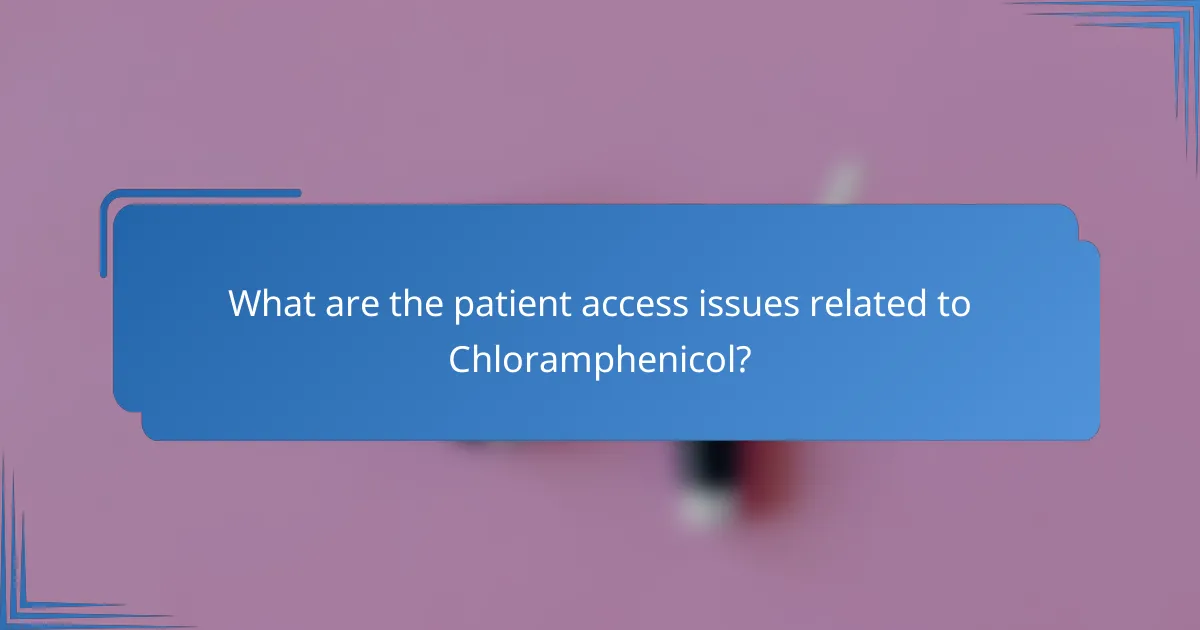Chloramphenicol is an essential antibiotic, but its cost barriers and availability issues pose significant challenges to patient access in Canada. High manufacturing expenses, limited insurance coverage, and price discrepancies among pharmacies contribute to these barriers, often resulting in untreated infections and adverse health outcomes. Disruptions in supply further exacerbate the situation, making it crucial for healthcare providers to navigate these challenges effectively.

What are the cost barriers for Chloramphenicol in Canada?
The cost barriers for Chloramphenicol in Canada primarily stem from high manufacturing expenses, limited insurance coverage, and price discrepancies among pharmacies. These factors can significantly impact patient access to this essential medication.
High manufacturing costs
The production of Chloramphenicol involves complex processes that contribute to its high manufacturing costs. These costs can be attributed to stringent quality control measures and the need for specialized equipment. As a result, the retail price of Chloramphenicol may be elevated, making it less accessible for some patients.
Manufacturers often face challenges in maintaining profitability while adhering to regulatory standards, which can further drive up prices. This situation can lead to fewer suppliers in the market, limiting availability.
Insurance coverage limitations
In Canada, insurance coverage for Chloramphenicol can vary significantly among different plans. Some insurance providers may not cover this medication at all, while others might impose high co-pays or deductibles. This inconsistency can create financial barriers for patients who need the drug.
Patients are encouraged to review their insurance policies carefully and consult with their healthcare providers about potential alternatives or assistance programs that may help offset costs.
Price variations across pharmacies
Chloramphenicol prices can differ widely from one pharmacy to another in Canada. Factors influencing these price variations include the pharmacy’s location, purchasing agreements, and overhead costs. Patients may find that shopping around can lead to significant savings.
To navigate these discrepancies, patients should consider using price comparison tools or apps that allow them to check prices at multiple pharmacies. This proactive approach can help ensure they receive the best possible price for their medication.

How does availability impact patient access to Chloramphenicol?
The availability of Chloramphenicol significantly affects patient access, as disruptions in supply can lead to shortages, making it difficult for healthcare providers to obtain the medication when needed. Limited access can result in untreated infections, increased healthcare costs, and adverse health outcomes for patients relying on this antibiotic.
Supply chain disruptions
Supply chain disruptions can occur due to various factors, including natural disasters, geopolitical tensions, or manufacturing issues. These disruptions can lead to delays in production and distribution, causing a shortage of Chloramphenicol in the market. Healthcare providers may struggle to find alternative sources, which can compromise patient treatment plans.
For example, if a major manufacturer faces production halts, the overall supply may dwindle, leading to increased prices and limited availability in pharmacies. Patients may experience delays in receiving their prescriptions, which can worsen their conditions.
Regulatory hurdles for importation
Regulatory hurdles can complicate the importation of Chloramphenicol, especially in countries with strict pharmaceutical regulations. These hurdles may include lengthy approval processes, compliance with safety standards, and tariffs that increase costs. Such regulations can limit the number of suppliers able to bring Chloramphenicol into a country, further impacting availability.
For instance, if a country requires extensive documentation for imported pharmaceuticals, this can delay shipments and lead to temporary shortages. Patients in these regions may find it challenging to access Chloramphenicol, forcing healthcare providers to consider alternative treatments that may not be as effective.

What are the alternatives to Chloramphenicol?
Alternatives to Chloramphenicol include various antibiotics that can effectively treat similar infections. These alternatives may vary in availability, cost, and specific use cases, making it essential to consider each option carefully.
Azithromycin
Azithromycin is a macrolide antibiotic commonly used to treat respiratory infections, skin infections, and sexually transmitted diseases. It works by inhibiting bacterial protein synthesis, making it effective against a wide range of bacteria.
One of the advantages of Azithromycin is its relatively low cost, often available for under $10 for a typical course in many regions. However, it is essential to be aware of potential side effects, such as gastrointestinal disturbances, and to use it judiciously to avoid antibiotic resistance.
Ciprofloxacin
Ciprofloxacin is a fluoroquinolone antibiotic that targets a variety of bacterial infections, including urinary tract infections and certain gastrointestinal infections. It functions by interfering with bacterial DNA replication, which is crucial for bacterial growth and reproduction.
This antibiotic is generally affordable, with prices often ranging from $5 to $20 for a standard treatment course. Patients should be cautious of possible side effects, such as tendonitis or gastrointestinal issues, and consult healthcare providers to ensure it is the right choice for their specific condition.

What are the patient access issues related to Chloramphenicol?
Patient access to Chloramphenicol is often hindered by several factors, including a lack of physician awareness and prescription restrictions. These barriers can limit the availability of this essential antibiotic, impacting treatment options for patients who need it.
Lack of physician awareness
Many healthcare providers may not be familiar with Chloramphenicol, leading to underprescription or misdiagnosis of conditions that could benefit from its use. This lack of awareness can stem from its historical association with serious side effects, which may overshadow its effectiveness in treating certain infections.
To improve awareness, continuing medical education programs should emphasize the appropriate use of Chloramphenicol, highlighting its benefits and risks. Physicians should be encouraged to stay updated on guidelines and emerging evidence regarding its use in specific patient populations.
Prescription restrictions
In some regions, Chloramphenicol may be subject to strict prescription regulations due to its potential side effects, such as aplastic anemia. These restrictions can limit access for patients who may benefit from the drug, particularly in low-resource settings where alternatives might not be available.
Healthcare providers should be aware of local regulations regarding Chloramphenicol prescriptions and consider advocating for more flexible guidelines that allow for its safe use. Patients should also be informed about their options and encouraged to discuss any barriers with their healthcare team to explore alternative treatments if necessary.

How do pricing strategies affect Chloramphenicol availability?
Pricing strategies significantly impact the availability of Chloramphenicol by influencing production costs, distribution, and patient access. High prices can limit access for healthcare providers and patients, while discount programs and bulk purchasing options can enhance affordability and availability.
Discount programs
Discount programs are initiatives designed to reduce the cost of Chloramphenicol for patients and healthcare providers. These programs can be offered by pharmaceutical companies, pharmacies, or healthcare systems, often providing medications at reduced prices or even for free to those who qualify.
For example, some manufacturers may offer coupons or patient assistance programs that allow eligible individuals to purchase Chloramphenicol at a fraction of the retail price. It’s essential for patients to inquire about such programs when prescribed this medication to ensure they are not paying more than necessary.
Bulk purchasing options
Bulk purchasing options allow healthcare facilities, such as hospitals and clinics, to buy Chloramphenicol in larger quantities, often resulting in lower per-unit costs. This strategy can be particularly beneficial for institutions that frequently prescribe the medication, as it can significantly reduce overall expenses.
Healthcare providers should consider negotiating bulk purchase agreements with suppliers or joining group purchasing organizations to maximize savings. However, they must also ensure that they have adequate storage and inventory management practices in place to handle larger quantities without compromising the medication’s efficacy.

What role do pharmacies play in Chloramphenicol distribution?
Pharmacies are crucial in the distribution of Chloramphenicol, ensuring that patients have access to this antibiotic when needed. They manage stock levels, handle prescriptions, and provide information on availability, which can vary significantly between local and online options.
Local pharmacy stock levels
Local pharmacies often face challenges in maintaining adequate stock levels of Chloramphenicol due to fluctuating demand and supply chain issues. Patients may find that some pharmacies do not carry this medication regularly, leading to delays in treatment.
To improve access, patients should call ahead to check stock availability before visiting. In some cases, pharmacies may be able to order the medication, but this process can take several days.
Online pharmacy options
Online pharmacies can provide an alternative source for obtaining Chloramphenicol, often with a wider selection and potentially better prices. However, patients must ensure they are using reputable online pharmacies that require valid prescriptions and adhere to safety regulations.
When considering online options, look for pharmacies that are licensed and have positive customer reviews. Additionally, be aware of shipping times and costs, as these can vary widely between providers.

What emerging trends could affect Chloramphenicol access in Canada?
Emerging trends that could impact Chloramphenicol access in Canada include regulatory changes, shifts in pharmaceutical supply chains, and evolving healthcare policies. These factors can influence both the availability and affordability of this antibiotic, affecting patient access significantly.
Regulatory Changes
Regulatory changes in Canada may alter the approval process for Chloramphenicol, potentially impacting its market presence. For instance, if Health Canada introduces stricter guidelines for antibiotic approvals, it could delay the entry of new suppliers or formulations, leading to shortages.
Conversely, streamlined regulations could facilitate faster access to Chloramphenicol by allowing for more generic versions to enter the market. This could lower costs and improve availability, benefiting patients who rely on this medication.
Pharmaceutical Supply Chain Shifts
Shifts in the pharmaceutical supply chain can significantly affect the availability of Chloramphenicol. Global disruptions, such as those caused by pandemics or geopolitical tensions, may lead to shortages of raw materials needed for production.
Additionally, if manufacturers relocate their production facilities or consolidate operations, this could impact the consistency of supply. Patients may experience delays in receiving their prescriptions, necessitating alternative treatments that may not be as effective.
Evolving Healthcare Policies
Changes in healthcare policies, such as funding for antibiotic stewardship programs, can influence the accessibility of Chloramphenicol. Increased focus on responsible antibiotic use may lead to more stringent prescribing practices, which could limit access for some patients.
On the other hand, policies aimed at improving access to essential medications may promote broader availability of Chloramphenicol. Initiatives that support public health could enhance patient access, ensuring that those in need can obtain this critical antibiotic without significant barriers.
